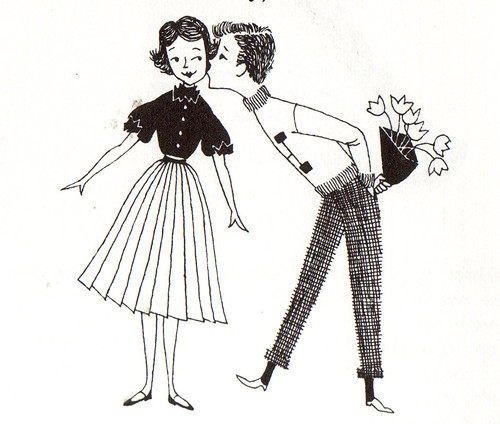First, let’s take a look at the general concept of
chastity:
From the Catholic Encyclopedia
 Chastity
is the virtue which excludes or moderates the indulgence of the sexual appetite.
It is a form of the virtue of temperance, which controls according to right reason the desire for and use of
those things which afford the greatest
sensual pleasures. The sources of such delectation are food and drink, by
means of which the life of the individual is conserved, and the union of the sexes, by means of which
the permanence of the species is
secured…
Chastity
is the virtue which excludes or moderates the indulgence of the sexual appetite.
It is a form of the virtue of temperance, which controls according to right reason the desire for and use of
those things which afford the greatest
sensual pleasures. The sources of such delectation are food and drink, by
means of which the life of the individual is conserved, and the union of the sexes, by means of which
the permanence of the species is
secured…
In another source, My
Catholic Faith, I found this exposition:
Chastity is that moral virtue which
disposes us to be pure in soul and body…
Chastity, opposed to lust, disposes us to preserve the mind
and body from everything that is impure. Chastity is purity. It is termed the angelic virtue, because it makes men
resemble the angels in heaven…
Chastity gives health to the soul and light to the
understanding; it aids wisdom and develops strength of character…
…For the unmarried, chastity forbids indulgence of the sexual appetite; for the married, it regulates the use of that appetite in
accordance with the dictates of right reason. It is wrong to suppose that
chastity is not a virtue for the married. God requires chastity from everyone,
in all states of life. A chaste marriage is the basis of the Christian family…
So, we have
chastity for the unmarried, which means total abstinence from the “sexual
appetite”. And we have marital chastity, which means that, within the state of
marriage, the sexual appetite is to be “regulated”.
Regulated how?
Well, I think the first thing many people think of is that the married couple
remains faithful to each other, that the marital relationship is exclusive. But
this is fidelity – which surely is related to chastity, but is not the same
thing.
Chastity is always
related to temperance, and temperance means, basically, controlling oneself.
Therefore, marital chastity means controlling one’s sexual desires within
marriage. It means that marriage does not justify indulgence of the sexual
appetite with an “anything goes” attitude.
In Pope Pius XII’s Allocution
to Midwives, there’s a very helpful section entitled “Human Dignity in
the Conjugal Act”. It says in part:
The same Creator, Who in His bounty and
wisdom willed to make use of the work of man and woman, by uniting them in
matrimony, for the preservation and
propagation of the human race, has also
decreed that in this function the parties should experience pleasure and happiness of body and spirit. Husband and
wife, therefore, by seeking and enjoying this pleasure do no wrong whatever. They accept
what the Creator has destined for
them.
Note,
though, that Pope Pius XII did not divorce that pleasure and happiness from the
procreative end of marriage. He keeps that end primary. “What the Creator has
destined” is that the marital act will often result in pregnancy. The Pope
continues:
Nevertheless, here also, husband and
wife must know how to keep themselves within
the limits of a just moderation. As with the pleasure of food and drink so with the sexual they must not abandon
themselves without restraint to the impulses of the senses. The right rule
is this: the use of the natural procreative disposition is morally lawful in
matrimony only, in the service of and in
accordance with the ends of marriage itself. Hence it follows that only in
marriage with the observing of this rule is the desire and fruition of this
pleasure and of this satisfaction lawful. For the pleasure is subordinate to
the law of the action whence it derives, and not vice versa—the action to the
law of pleasure. And this law, so very reasonable, concerns not only the
substance but also the circumstances of the action, so that, even when the substance of the act remains
morally safe, it is possible to sin in the way it is performed.
In
other words, it is lawful and moral to pursue the pleasure of the marital
embrace, but there are limits. We are not given a green light to pursue
anything sexual that strikes our fancy, even within marriage.
 The transgression of this law is as old as original sin. But in our times there is the risk that one
may lose sight of the fundamental principle itself. At present, in fact,it is usual to support in words and in
writing…the necessary autonomy, the proper end, and the proper value of
sexuality and of its realization, independently
of the purpose of procreating a new life. There
is a tendency to subject to a new examination and to a new norm the very order
established by God and not to admit any other restraint to the way of
satisfying the instinct than by considering the essence of the instinctive act.
In addition there would be substituted a license to serve blindly and without
restraint the whims and instincts of nature in the place of the moral
obligations to dominate passions; and this sooner
or later cannot but turn out to be a danger
to morals, conscience and human dignity.
The transgression of this law is as old as original sin. But in our times there is the risk that one
may lose sight of the fundamental principle itself. At present, in fact,it is usual to support in words and in
writing…the necessary autonomy, the proper end, and the proper value of
sexuality and of its realization, independently
of the purpose of procreating a new life. There
is a tendency to subject to a new examination and to a new norm the very order
established by God and not to admit any other restraint to the way of
satisfying the instinct than by considering the essence of the instinctive act.
In addition there would be substituted a license to serve blindly and without
restraint the whims and instincts of nature in the place of the moral
obligations to dominate passions; and this sooner
or later cannot but turn out to be a danger
to morals, conscience and human dignity.
And
we talk about Humanae Vitae containing
prophetic statements! In this Allocution
to Midwives, published in 1951, seventeen years before HV, Pope Pius XII is saying that when we divorce the procreative
end of marriage from the “unitive” end, we put our souls in danger because we
(as a society) will sooner or later succumb to the pursuit of pleasure in the
sexual act independent of procreation. Is this not what we see today? Never
mind even the pervasive use of artificial contraception – think about
homosexual “marriage”. Seeking sterile sex is dangerous because it perverts the
natural order of the relationship between man and woman, and refutes the intrinsic link between the marital embrace and procreation.
Pope
Pius XII has more to say about that link:
If nature had aimed exclusively, or at least in the first place, at a
reciprocal gift and possession of the married couple in joy and delight, and if it had ordered that act only to make happy in the highest
possible degree their personal
experience, and not to stimulate
them to the service of life, then the Creator would have adopted another plan
in forming and constituting the natural act. Now, instead, all this is
subordinated and ordered to that unique, great law of the "generatio et
educatio prolis," namely the accomplishment of the primary end of matrimony as the origin and
source of life.
Unfortunately, unceasing waves of hedonism invade the world and threaten
to submerge in the swelling tide of thoughts, desires and acts the whole
marital life, not without serious dangers and grave prejudice to the primary duty of husband and wife.
 |
The following excerpts from two
interesting articles on LifeSiteNews earlier this year provide a good example of
marital chastity “in action” – even in today’s sex-obsessed culture, and even
considering the issue of same-sex attraction.
In “Confessions of a Recovering Lesbian”, author Dawn Wilde –
who once lived a homosexual lifestyle but is now married with children – notes
that she does face temptations because of her tendency toward same-sex
attraction, but that
… I remain faithful to God and my
husband because I work hard to avoid
near occasions of sin. For instance, I avoid deeply emotional friendships with
women that eclipse the one with my husband. I don’t watch gay- and
lesbian-themed movies. I also have trained my imagination to avoid impure fantasies. It can be
tempting to fall into old thought patterns, especially if I’m tired. But if
necessary, I’ll shut down physically and emotionally to avoid offending God. No fleeting sensual pleasure is worth
offending Jesus, who suffered so much to save me.
That’s marital chastity. That's preserving one's purity.
In her other article, “Life After Lesbianism”,
Dawn notes:
People who interpret these temptations
as evidence I’m suppressing my true self have an immature understanding of what love—especially married
love—actually is. It’s true that love is often sparked by a sexual attraction,
and ours was no exception. But love is ultimately expressed in action, not in feelings...Love is making dinner and doing laundry after a full day at work because your
wife is puking her guts out from morning sickness. Love is sacrificing time to
yourself so your husband can go on a retreat to get closer to the Lord. Love is
wiping the vomit off your terminally-ill wife’s aged face…changing your
comatose husband’s adult diapers…caring for her even after she has forgotten
who you are. Love is the Cross.
That
last statement reminds me of the homily I transcribed here, where the priest
notes that during the wedding ceremony, the couple faces not each other, but
the Cross:
 Their marriage itself and their very
first act of married life together, take place in the shadow of the Cross. It’s
a stark reminder that in this fallen world, there is no escaping the Cross: the
price of re-creation, the price of order replacing disorder, the price of grace
driving away sin, the price of their marital happiness, the price of their
eternal happiness is present, overshadowing their marriage from the beginning.
Their marriage itself and their very
first act of married life together, take place in the shadow of the Cross. It’s
a stark reminder that in this fallen world, there is no escaping the Cross: the
price of re-creation, the price of order replacing disorder, the price of grace
driving away sin, the price of their marital happiness, the price of their
eternal happiness is present, overshadowing their marriage from the beginning.[They have come together] at the foot of the Cross, and kneeling before it they have vowed to spend their lives facing it, together. Now they’re engaged in a loving contest to grow in holiness.
Dawn Wilde seems to have an exquisite understanding of that point. Marriage is about growing in holiness:
overcoming temptations, putting one’s spouse first, learning to control the
sexual appetite in order mature in mutual love. Marital chastity fosters that growth.
(If you wonder why I have included no references to the Catechism of the Catholic Church, Theology of the Body, Humanae Vitae, etc…stay tuned for Part 2!)
(If you wonder why I have included no references to the Catechism of the Catholic Church, Theology of the Body, Humanae Vitae, etc…stay tuned for Part 2!)

Great post! This topic is seldom talked about. When I was instructing my own teenage daughter about chastity, she was shocked to find out that it applies to married people too. She didn't think married couples had to "worry" about that anymore.
ReplyDeleteAnd of course it all relates to some of what is taught in NFP classes, too.
ReplyDeleteI was listening to a recorded sermon on the 6th and 9th commandments today(at www.audiosancto.org)...boy oh boy, what we DON'T teach our children about the sins against purity in the "dating" scene - but which of course we should...if we even knew ourselves.
I did a series on the Pope's encyclical Deus est Caritas and I brought up some of these points. Keep writing on this. Modernism is in the seminary and theological colleges of the world and the ideas you have highlighted and which were the teaching of the Church for years have been almost lost.
ReplyDeleteI also blame modern philosophy and the fact that Aquinas and Augustine are "electives" in many seminaries.
I am "off" TOB.
sorry in a hurry Deus Caritas Est, of course
ReplyDeletePS
ReplyDeleteWould you like to comment on the fact that permanent deacons were originally not to have relations with their wives after ordination and this is not being taught to them or demanded. Also, the same is true in the new Ordinariate, although there has been a consent from Rome on an individual basis to allow conjugal rights, but I here that is changing and that the coming round of priests will be asked to be totally chaste in marriage--that is, celibate.
Supertradmum - I keep thinking about writing about the deacon/conjugal rights issue! That's an interesting thought in conjunction with this general issue of marital chastity. Dr. Ed Peters has done a masterful job of explaining and commenting on the issue.
ReplyDelete